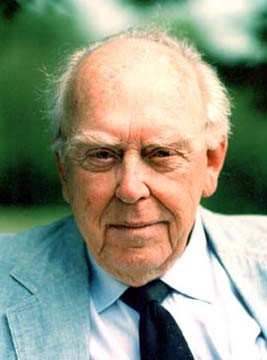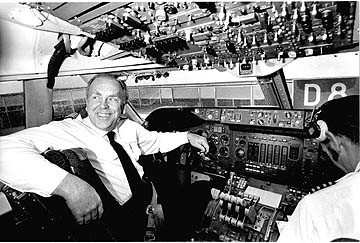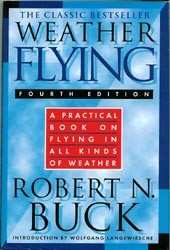Teenage Flier, Airline Pilot, "Weather Flying"
Author Was 93
 It is with sadness
Aero-News recently learned Robert N. Buck, 93, died April 14 in a
Berlin, VT hospital of complications from a fall. The former Trans
World Airlines pilot and aviation author set flying records as a
teenager in the 1930s and flew severe-weather research missions
during World War II.
It is with sadness
Aero-News recently learned Robert N. Buck, 93, died April 14 in a
Berlin, VT hospital of complications from a fall. The former Trans
World Airlines pilot and aviation author set flying records as a
teenager in the 1930s and flew severe-weather research missions
during World War II.
Buck began his stellar aviation career as a 15-year-old glider
pilot in New Jersey in 1929. The longtime AOPA Air Safety
Foundation Board of Visitors member flew until he was 88.
"He remembered staring out of the window in ninth grade and
dreaming about flying; it was just the love of his life," daughter
Ferris Buck said.
She said her father instructed her and her brother Rob, a
retired Delta Airlines pilot, to never hold a formal "celebration
of life" for him after his death.
"So we had a party for him at his house Sunday," she said. "At
the end of the party, some of the local pilots did a fly-by, and
one young man did incredible stunts over the house.
"A retired pilot friend of mine said, 'Whenever I saw your
father, I was awestruck because he was one of the real aviators,
and we just came later,'" she added.
Buck was born in on Jan. 29, 1914, in Elizabethport, NJ and grew
up in Westfield. When he was 15, he and a fellow high school
student built and flew their own glider, which was towed by a Model
A Ford at a local grass airstrip.
In April 1930, the 16-year-old Buck earned his private pilot's
license and set a 15,000-foot junior altitude record three months
later.
On September 29, 1930 -- reportedly equipped with six
chocolate bars and a canteen -- Buck climbed into a Pitcairn
Mailwing at Newark Airport and took off for Los Angeles making an
attempt at the junior transcontinental airspeed record, which he
did by an hour and eight minutes.
According to an Associated Press account, the seven-stop flight
lasted 28 hours and 33 minutes. Buck set another junior record on
his return trip to Newark: 23 hours and 47 minutes, according to
his log book.
He told the story of his early days as a pilot in his first
book, "Burning Up the Sky," published in 1931 by G.P. Putnam's
Sons. The press dubbed him "The Schoolboy Pilot."
Buck's long list of records also included a flight from Newark
to Havana in 1931 in 14 hours and 47 minutes, according to the
family. He and his parents later met with President Herbert Hoover
at the White House, where Buck presented Hoover with a foot-long
Cuban cigar.
Buck also established a Newark-to-Mexico City junior record in
1932 of 24 hours and nine minutes, according to the Los
Angeles Times.
Then, in 1936, at the age of 22, Buck established a nonstop
long-distance record in a straight flight from Burbank to Columbus,
OH. The next year, he joined TWA (then Transcontinental and Western
Air) as a co-pilot rising to captain three years later.
"When I was a young captain -- and I looked young --
some lady said to the hostess, 'Is that the co-pilot?' And she
said, "No, that's the captain.' And she got off the airplane at
Pittsburgh," Buck recalled in a 2002 interview with National Public
Radio.

He also flew as a civilian pilot for the Air Transport Command
during World War II flying personnel and material to the African
and European theaters.
When TWA was awarded an Army Air Forces project to research
weather during the war, Buck served as the project's pilot and
manager, flying a B-17 from Alaska to Brazil to investigate radio
interference from static caused by precipitation, including rain
and snow, according to the Times.
"I was able to put my nose in any kind of weather I wanted to
fly through," he said in the National Public Radio interview. "We'd
sit around, waiting until the weather was bad and then go fly
through it."
As a result, he became one of the few civilians to be awarded
the Air Medal for his weather research.
Buck was named TWA's superintendent of flying (chief pilot to
us) in 1945 and was command captain in the delivery of the
carrier's first Lockheed Constellation, the modern pressurized,
four-engine, high-speed transport of its time.
Buck, who served on weather and air safety committees for what
later became NASA, won the Air Line Pilots Assn. Air Safety Award
in 1963. He also served on the FAA's Supersonic Transport
Committee.
 He flew a DC-3 with
actor Tyrone Power on a 20th Century Fox publicity trip through
South America, Africa and Europe. Power, who had been a Marine C-46
Transport pilot during the war, did a majority of the flying and
became a close friend of Buck.
He flew a DC-3 with
actor Tyrone Power on a 20th Century Fox publicity trip through
South America, Africa and Europe. Power, who had been a Marine C-46
Transport pilot during the war, did a majority of the flying and
became a close friend of Buck.
In 1965, he made a round-the-world trip that covered both poles
flying a Boeing 707 in shifts with several other pilots. In
1970, he inaugurated TWA's New York-to-London and New York-to-Paris
747 service.
He was forced into retirement from TWA at the requisite age of
60 in 1974 but continued to fly general aviation aircraft,
including sailplanes.
Buck's 1970 book "Weather Flying," is considered a must-read for
pilots. He also wrote "Flying Know-How," "The Art of Flying," "The
Pilot's Burden: Flying Safely and the Roots of Pilot Error" and
"North Star Over My Shoulder," his 2002 memoir.
"Bob Buck was indeed captain to a whole generation of pilots,"
said Dr. Ian Blair Fries, a fellow Air Safety Foundation Board of
Visitors member. "His 'Weather Flying' began as a giveaway brochure
for an aviation insurance company and grew into the best commentary
we have on flying and weather. His thoughtful proposal to the
novice on how to tackle easy weather situations first still
provides the best way to assess the difficulty of any IFR flight.
We who have known him have been honored and will miss his sage
advice."
Buck was preceded in death by his wife of 66 years, Jean, in
2004, but he continued to live independently, his daughter
said.
"The night before he fell down, he made dinner for my husband
and me -- beef brisket and homemade pumpkin pie," she said. "He did
all his own mowing and cooking. He really was a remarkable
man."
Robert N. Buck has gone west. For most, the skies there are
clear... but we imagine Buck was greeted by some stormy
weather. And he wouldn't have had it any other way.
 ANN's Daily Aero-Linx (05.06.25)
ANN's Daily Aero-Linx (05.06.25) ANN's Daily Aero-Term (05.06.25): Ultrahigh Frequency (UHF)
ANN's Daily Aero-Term (05.06.25): Ultrahigh Frequency (UHF) ANN FAQ: Q&A 101
ANN FAQ: Q&A 101 Classic Aero-TV: Virtual Reality Painting--PPG Leverages Technology for Training
Classic Aero-TV: Virtual Reality Painting--PPG Leverages Technology for Training Airborne 05.02.25: Joby Crewed Milestone, Diamond Club, Canadian Pilot Insurance
Airborne 05.02.25: Joby Crewed Milestone, Diamond Club, Canadian Pilot Insurance





